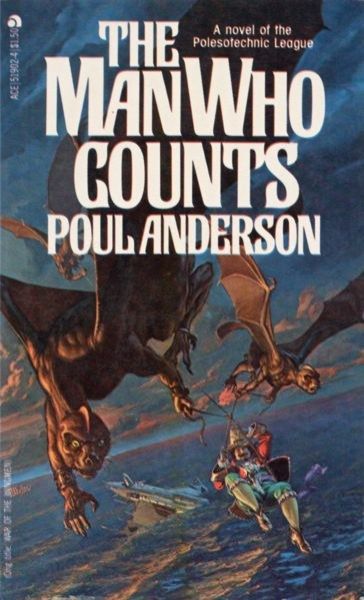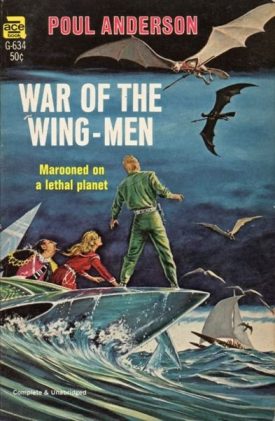A Fateful Trip
The Man Who Counts
By Poul Anderson

1 May, 2022
Poul Anderson’s 1958 The Man Who Counts is a science fiction novel. It’s one of the Nicolas van Rijn novels, which are set in Anderson’s Polesotechnic League timeline, which itself is part of the much larger Technic setting.
Master star-trader Nicolas van Rijn is one part Falstaff, one part merciless trader, entirely Dutch Indonesian. Not everyone likes the merciless trader part. One such enemy must have planted the bomb on van Rjin’s starship. While the bomb failed to kill van Rijn, it did maroon van Rijn, Lady Sandra Tamarin, and engineer Eric Wace on the giant world Diomedes. If they stay there, they will die slowly. A quick death due to bomb might have been preferable.
Although the planet Diomedes is twice the radius of Earth, its surface gravity is only ten percent more. This low density is due to a general lack of heavy elements. Terrestrial food, which has more heavy elements, would poison native life. The local biochemistry is just as lethal to terrestrials such as the three castaways.
The good news is that van Rijn, Wace, and Lady Sandra managed to salvage about a month and a half worth of food before their ship sank. Even better, they’ve encountered kindly natives who took them onboard a raft-navy. Transport! There’s a Polesotechnic League trading post on Diomedes. Reach it and rescue is assured.
Alas, even small planets are big. Diomedes is bigger than most. The post is ten thousand kilometres away. While van Rijn does speak a native language, it’s from a region half a planet over. It is as though the humans were trying to make their way from Kitchener to Tokyo knowing only Japanese.
The communications barrier is surmountable. Other issues are not. The humans have landed in the midst of a bitter, brutal war. The Fleet of Drak’ho, following migrating fish into the Sea of Achan, covets the island of Lannach. Perhaps the Fleet might have felt vaguely guilty about commandeering the Lannachs’ land except for the fact that the Lannachs’ sex and marriage customs are completely different from those of the Fleet. Both sides see the others as irredeemable perverts and genocide as the only right thing to do.
The war is turning in the Fleet’s favour. They are busy; they don’t want to put any time and effort into assisting the humans. Therefore the humans decide to ditch the Fleet and propose an alliance with the Lannachs: they will help the Lannachs resist the Fleet and the Lannachs will help the humans reach the trading post.
The humans only have food for six weeks. They have to win the war and make it to the trading post within that time.
[break]
Ace retitled the novel as War of the Wingmen, because that’s the sort of thing that Wollheim, then in control, did.

The original title was restored with the 1978 edition. Which as it happens is the one I own. This edition includes a rather defensive introduction by Poul Anderson. Defensive Introductions to His Own Older Works by Poul Anderson was a thriving field in the 1970s.
Lady Sandra isn’t as bad (she’s without agency or talent, a stereotyped female) as the female characters in many early Poul Anderson novels. But bear in mind that the character in one such novel turned out to have been dead the whole time. We’re told that Lady Sandra is the last hope of an otherwise inbred Hermes royal family. That isn’t something relevant to the plot, in which she is largely a dead-weight passenger and exists only to be the love-interest reward for “the man who counts” (van Rijn).
However, there is a woman who has her own agenda, which she pursues as ruthlessly as van Rijn pursues his: the Fleet’s Rodonis, who commits murder, frames an innocent person, and then blackmails them over a crime they did not commit. It’s true she does this entirely to get her husband out of an unjust death sentence, but points for audacity and success.
As for the other human: Eric Wace is just another Campbell-era hero-engineer. However, he’s not the protagonist. Not “the man who counts.” That’s the unattractive, ruthless, unethical boss Nicolas van Rijn. Van Rijn is the sort of villain who will cheerfully frame Rodonis’ husband to buy time for an escape. In most SF novels of this era, Wace would have been the hero, with van Rijn either relegated to comic relief or minor impediment who has to be sacrificed for the good of the many. Readers may have been astounded by Anderson’s rejection of this era’s conventions.
This is in many respects a fairly standard Mighty Whitey novel (van Rijn even gets to humansplain native biology and reproduction to the natives). But there are a couple of ways in which this novel is better than most:
Wordbuilding: Poul Anderson invests a lot of effort creating plausible flying aliens and their homeworld. That’s a lot of work for a book that was likely intended as a one-off. Diomedes’ natives are not the only flyers in the Technic setting, but the other Anderson treatment of such a species solves the problem of how to reconcile large brains with the energy demands of flying in an entirely different way. Because Anderson thought that sort of worldbuilding play was fun.
Cultural diversity: Diomedes is large and multi-cultural. Languages differ; customs differ (hence the Fleet-Lannach war, sparked by mutual xenophobia1). Many SFF authors don’t bother with imagining more than one culture and language per species, let alone per planet.
Readers looking for an author who could be counted on for plausible settings, physical and cultural, should look for Poul Anderson works. That’s not to say that they will like Anderson’s other cultural baggage….
The Man Who Counts is available here (Amazon UK) but it does not appear to be available as an independently bound book from any other source that I can name.
1: Of course, this being 1950s SF, it turns out that both cultures are the way they are for purely physical reasons: the Diomedean reproductive cycle has a trigger. One group is continually subjected to that trigger and breeds year-round, with social customs to facilitate that; the other group is only intermittently subject to the necessary condition and their social customs suit those circumstances.
This kind of explanation is, as you know Bob and Bobette, par for the course for 1950s SF. See, for example, the explanation of the origins of Asian art in Pohl and Kornbluth’s Wolfbane:
But at last, in the 1,000 to 1,500 calorie range, Artistic-Technological Style firmly appears in self-perpetuating form. (Calories per person) in that range produces the small arts, the appreciations, the peaceful arrangements of necessities into subtle relationships of traditionally agreed-upon virtue.
Think of Japan, locked into its Shogunate prison, with a hungry population scrabbling food out of mountainsides and beauty out of arrangements of lichens. The small, inexpensive sub-sub-arts are characteristic of the 1,000 to 1,500 calorie range.
Presumably, were authors of this period to examine why the British drive on one side of the road and Americans on the other, it would come down to some inherent factor in their genetic or physical circumstances.
